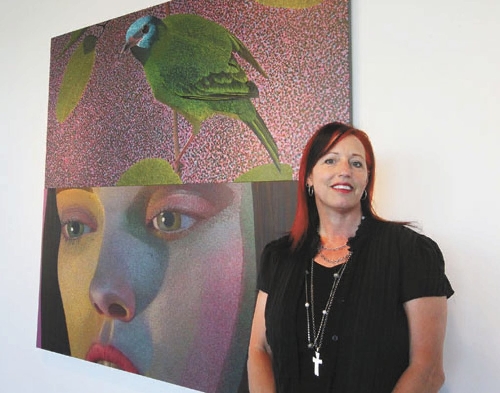Experts offer advice on the art of art collecting



Got spare millions?
We’re not speaking to you. (No offense.) Got an aesthetic sense but not unlimited cents? We’re speaking to you. Forgive our language, but the subject is …
Art collecting.
“I’d love to come up with another term to demystify that,” says Victoria Hart, director of downtown’s Brett Wesley Gallery. “People think of art collecting as million-dollar paintings and it’s not really.”
No million smackers? Phew. Still: How big a discount we talkin’ about?
“I just bought one of (one-time Las Vegas artist) Casey Weldon’s really small paintings, but still an original work by a local artist — for $150,” Hart says. “And for some people $150 is a lot of money, so if you really love something and want to start your collection, most galleries have what’s similar to a layaway program.”
(Let’s separate “inexpensive” from “cheap.” Some art collection websites peddle pieces for less than 50 bucks. We can’t confirm if that includes “Dogs Playing Poker” and “Velvet Elvis.”)
Yes, you Las Vegans convinced that culture bypassed our glitzy burg — your neighbors do purchase art. “I’ve had half a dozen shows around town,” says local artist Kevin Chupik, an adjunct art instructor at the College of Southern Nevada. “I was able to sell the majority of the shows out with pieces that ranged from under $500. And I’ve seen the higher end where my work is selling for between $5,000 to $6,000.”
Here’s a brief tutorial for this hobby — make that “avocation” because this is classier than amassing vintage bottle caps — from the artistically informed:
■ Don’t fall in like with a piece. Fall deeply, soulfully in love. “Most of the time when people buy art, they own it for a long time because it’s such a personal experience with that piece,” Hart says. “Make sure when you buy something, it resonates with you.”
■ How does a novice become a non-novice? First, try First Friday, the monthly Arts District block party. “It’s a great opportunity to look at a lot of art from a lot of galleries and get a feel for the artist and pricing,” Hart says. “First Friday isn’t great for sales, but it’s an educational tool for us. Our biggest nights are the night before, Preview Thursday, when we open a show and invite collectors and enthusiasts.”
Collector Ed Shull, whose private stash includes eight oil paintings worth thousands, adds an amen.
“I credit First Friday for turning me into a collector,” he says. “It’s in a lot of cities with a lot of talented people, but in Vegas, for some reason, I found it especially compelling.”
■ What if Friday’s bowling league night? “I would look for fundraisers where they’re having an art component,” Hart says. “You can pick up art very affordably at those.”
Philosophically, Chupik says, “take the mystery out of it. With the proliferation of ArtWalks and First Fridays, there’s no excuse not to know what’s going on. The best place is a student show. Make an offer to a student for images you respond to, drawings, paintings, prints or sculptures. I had a patron follow me through my undergrad years buying a dozen pieces that span 15 years of work. He started by encountering it in the hallways of Texas Christian University.”
■ Should we get to know you artist types — hang out together at Chuck E. Cheese? “I prefer to have a relationship with somebody who buys my art,” says local artist Mikel Patrik. “It adds an extra layer of interest. I have friends and clients who’ve followed how I’ve transitioned over the last 2½ years.”
■ Is there a procedure for procuring art that, if violated, compels your arrest by the art police? “There’s no right way to collect, that’s the fun of it,” Hart says. “Some people will purchase a bunch of pieces from a single artist all at once, or some collect one a year, or they’ll commission their favorite artist to do an individual piece that’s more personal.”
Inside tips for insider wannabes? “I saw one piece at a gallery in Chicago, I really liked the style, but it was insanely expensive,” Shull recalls. “I kept track of the artist and later I looked him up, he had a piece I liked better and it was significantly less money than going to the gallery. It would have cost four times what I paid if I got it at auction.”
Dissing galleries, Ed? “Galleries have a valuable service in bringing artists out, but if you’re starting a collection, seek out artists you like directly. Also, if you like a (gallery) painting, the gallery may say it’s going to go quickly, but people tend to think about it.”
■ Yo — rich kids! This part’s for you. “When you spend $5,000 to $10,000, you start thinking about investment-grade potential,” Hart says. “Art has actually outperformed the S&P 500. If you’re looking to collect investment-grade work, you should meet with a gallerist or art consultant. They’ve done research on artists and why they’re valued at where they’re at. It’s an amazing investment if you’re really savvy.”
■ Tell us an art story, Vicki. “Herb and Dorothy (whose story was made into a film) were a young couple in New York. He was a postal worker and she was a librarian. They loved art, so they started buying pieces for $100, $200, commissioned directly from artists starting out. They always bought small pieces because their apartment was tiny. Now they have a collection worth multimillions of dollars that they lend out to museums. Anybody can do that.”
■ Whatever you pay, practice post-purchase common sense and spare the artist nightmares. “They may put it in a godawful frame,” Patrik says. “They might hang it upside down. There was a client who took one meant to be horizontal and she was like, ‘Well, what if we hang it vertically!’ That wasn’t my intent. A lot of people don’t hang their art at the right height, either.”
Upside down, sideways, out of eye-level range — wouldn’t that improve “Dogs Playing Poker”?
Contact reporter Steve Bornfeld at sbornfeld@ reviewjournal.com or 702-383-0256.












